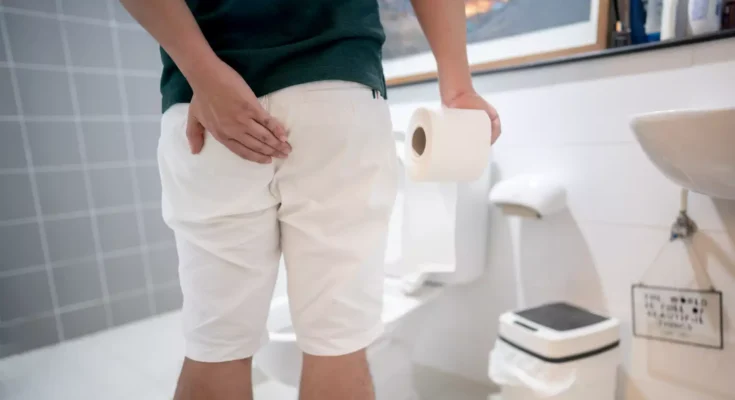Everyone takes a number 2, but there’s no second way to wipe your bum.
Hopefully, there is no debate on this, but wiping your anus should be something you’re anal about.
Nobody wants to walk around the mall with a slippery ass, and thankfully (due to advancements in society) there are a lot of methods you can use to ensure that no poo is on your bum when you leave the restroom.
However, while you might think you’re doing it right, you could be wrong.
Do you really want to risk that?

Do you wipe the right way? (YouTube/MannyMeachum)
Of course not. You would be a fool to ignore the rest of this article, and a laughingstock if anyone ever realized that you wipe like an alien.
Anyway, there has finally been an answer on how you can wipe your bum the right way, and I’m really hoping that you’re aware of how to do this already.
When you’ve got to go, you’ve got to go.
According to a YouTube video posted by Manny Meachum, there are different ways that different cultures take care of themselves in that area.
First, you have the United Kingdom, who wipe (sloppily, apparently), Russia who allegedly use a pogo stick to insert and exit the anus with tissue attached to the stick handle of a plunger (cap or not?) and more.
While Ivan Pipenheimer showcased Russian’s technique, Neil DeAss Tyson showed how the US do it, which is to neatly fold tissue after each wipe, and then finish it off with a wet wipe for that slippery fresh feel.
Europe apparently uses a bidet to wash their bums, and this appears to be the clear winner.
However, if you’re not into using water, you need to know how to wipe properly.
As per Amber J. Tresca, a digestive health writer for VeryWell, there’s only one way that’s the right way.
Front to back.
Basically, after you poo, it’s time to wipe from front to back, which is ‘especially important for people with vaginas as it prevents feces from entering their urethra’.
If you don’t want a UTI ladies, don’t wipe back to front.
While penis-havers are less likely to get a UTI, wiping front to back will stop poo from lodging itself under the foreskin or on the tip of the penis.
So really, it’s just good practice to wipe the right way.
To do this, grab toilet paper, reach behind your back and between your legs and wipe in the direction of the back of the toilet.
Use as much tissue as you need, or wet wipes until you can no longer see poo on the paper.
But don’t scrub your bum, as this could cause microtears in the skin, causing bacteria to enter and causing an infection.
If you can’t reach around, then reach between your legs and continue to wipe front to back.
If it’s a messy job, then hopping in the shower is a great idea, but if you can’t, maybe arming yourself with a pack of wipes and spare underwear will do the trick.

A doctor has finally revealed the truth on whether cracking your knuckles can give you arthritis amid ongoing confusion on social media.
There’s no doubt that cracking your knuckles provides a lot of satisfaction – but many of us would stop as a kid due to the advice issued by our parents.
Many myths regarding cracking your knuckles exist online, including the fact they break the bones of your deceased loved ones, and the number of clicks you hear indicates how many people love you.
While those theories are pretty outlandish, the saying that cracking your knuckles can lead to arthritis did have some validity to it in some people’s eyes.

A doctor has revealed the truth about knuckle cracking (Getty Stock Photo)
This was likely fuelled by parents who warned them against the cracking of knuckles due to the apparent risk of arthritis.
Now, a doctor has set the record straight about knuckle cracking.
What is the sound when you crack your knuckles?
Dr. Robert Klapper, an orthopaedic surgeon, told Cedars Sinai: “The noise of cracking or popping in our joints is actually nitrogen bubbles bursting in our synovial fluid.”
It’s synovial fluid that lubricates joints like ‘motor oil in a car’s engine’, according to the doctor, which ultimately reduces friction.
The nitrogen bubbles within this fluid typically take 20-minutes to re-form within the joint, meaning you have to wait that long to crack again.
Can cracking your knuckles cause arthritis?

Cracking your knuckles does not lead to arthritis after all (Getty Stock Photo)
Dr. Klapper said: “Cracking your knuckles does no harm at all to our joints. It does not lead to arthritis.”
While the joints might pop and crack, the doctor states knuckle cracking causes no harm whatsoever.
Dr Mutahir Faran, who goes by @madmedicine on TikTok, also backed up these claims with a video posted to the popular video site.
“A lot of people think that cracking your knuckles is going to lead to arthritis but that’s actually not true,” he said.
“When you crack your knuckles you’re actually popping the bubbles that are formed in your joints in your synovial fluid.”
Dr Donald Unger previously carried out a study on the matter, which Dr Faran explained in the video.
He said: “Dr Donald Unger actually cracked the knuckles on his right hand ONLY, for 60 years and then compared them to his left hand.
“He found that there were no changes in his joints.”
So there you have it, knuckle cracking does not lead to arthritis after all.
Told you, mom and dad.

Each week people on the internet are making a revelation about something, and one week in 2025 believe it or not, it’s toe nails of all things.
While it can certainly be easy to forget, it’s extremely important to cut your toenails for general foot health.
But how is the correct way to cut your toe nails?
Those who suffer from ingrown toenails will know how painful it really is, but you may be suffering from them because of the way you cut your toenails.

You’ve been cutting your toenails wrong all these years (YouTube/Creative Learning)
A video uploaded by Creative Learning, documents how you should cut your nails, and it made clear you should cut your toenail straight.
The clip went on to explain how you shouldn’t cut your toenails too short and also avoid ’rounding the edges’.
A similar video has been uploaded to the ‘Interesting As F***’ Twitter account, with many shocked at how you really should be cutting your toe nails.
“Can confirm the first method causes ingrown toenails and they huuuurt,” one person said.
A second added: ” Cut toenails straight across to prevent ingrown nails. Don’t cut too short, and file sharp edges. Trim after a shower for softer nails. Simple care, fewer problems.”
While a third remarked: “I have definitely been cutting my toenails wrong my whole life lmao.”
Healthline has also done a handy guide on how best to cut your toe nails, and it all begins with the nail clippers.
The website explained: “You should have two nail clippers — one for your fingers and one for your toes. Since your toenails are broader and thicker, they require a larger clipper. Also, by having separate clippers, you reduce the chance of transferring bacteria or fungus between your feet and hands.”
You also need to clean your clippers throughly between each use for obvious hygiene purposes.

The video documents how to clip your toenails correctly (YouTube/Creative Learning)
Healthline went on to say you should probably cut your toe nails every six-eight weeks, though someone who is more active may have to do it more often.
And speaking of the actual cut itself, the site read: “The fifth step is the actual cut. To avoid painful ingrown toenails, cut your toenails straight across. For many people, this is easiest to do in two cuts — the first one with the clippers slightly off the side of the nail to create a straight edge; the second to remove the rest of the nail following the line of the straight cut.”
You’ll want to finish that off with a bit of nail filling to remove those ‘jagged edges’.
While it really shouldn’t be that big of a deal, the way people hang toilet paper is taken quite seriously on the internet.
I mean, there are a lot more serious questions to be discussed, but toilet paper etiquette is seemingly up there for a lot of people.
It really is an age-old question that no one seems to have an answer for: ‘Should a toilet paper roll face over or under when on the holder?’
People have their reasons and explanations for both sides of the argument, though there is seemingly a right answer amongst all the discussion.
Where this answer is, you ask? Well, it’s found in the original patent for the toilet paper roll.

The correct way to hang toilet paper has been revealed. (Getty Stock Images)
Toilet paper was patented way back in 1871, with a man named as Seth Wheeler credited with the invention.
Come 1891, the roll-style toilet paper that we all buy was re-patented, with credit again to Seth Wheeler.
In the creator’s improved patent for toilet paper, he described the idea of perforated toilet paper on a roll.
The sheets are meant to be “partially separated, having their points of attachment arranged in a novel manner, whereby each sheet will easily Separate from the series as it is drawn from the roll, there being no litter occasioned, and any Waste of paper is thereby prevented.”
Wheeler then went on to illustrate his concept, including referring to the burning question of how it was to be used.
The drawings describe “a view of [the] improved roll suspended on the simplest form of fixture.”
While the creator may not have directly addressed how toilet paper should hang, his illustrations make his thoughts pretty obvious.

We now know the truth. (Seth Wheeler)
The pictures show the roll facing out, with one particular illustration showing the roll on a toilet paper holder, still facing outward.
So, the answer as to whether toilet paper roll should face over or under when on the holder is, in fact, OVER.
Jackie, an expert in this sector, echoed this sentiment after speaking to the Daily Mail.
She said: “Research after research reveals that the proper and most hygienic way to hang your toilet paper is over and not under.
“Might I add, that goes for paper towels too, if hanging from the wall. Not only is it hygienic, it lends to maintaining proper hygiene, which is proper etiquette.”
And she reminded people that Wheeler actually listed the correct way to hang toilet roll in the diagram.
Featured Image Credit: Getty Stock Images

As the seventh season of Rick and Morty hits our screens, the adult-comedy has finally revealed its new voice actors.
It comes after months of speculation about the sci-fi series, following Justin Roiland’s departure earlier this year.
However, fans have been left impressed with the new voices of the show as the latest season debuted over the weekend.
Prior to leaving the Adult Swim series, Roiland had voiced the titular grandfather and grandson duo for six seasons.
However, the network opted to end its relationship with the Rick and Morty showrunner after he was charged with domestic violence offences.
The incident took place in 2020 and he pleaded not guilty to one count of domestic battery with corporal injury and one count of false imprisonment by menace, violence, fraud and/or deceit.
While the charges were dropped, it left the show without a voice for its two main characters.

Adult Swim
Following this, execs were on a mission to find a replacement and one that sounded virtually identical to the previous seasons.
Understandably, Adult Swim was eager to let the new series ‘speak for itself’ with the actors’ identities only being revealed as the first episode aired on 15 October.
Now, it’s been confirmed that Ian Cardoni is the new voice of Rick Sanchez, while Harry Belden voices his grandson Morty Smith.

Adult Swim
It’s the first lead voice role for both actors, with Cardoni previously narrating as Jack Sparrow for WrestleMania 36 and 37.
Meanwhile, Belden has had roles in Chicago Med, Proven Innocent and Christmas…Again?!
They aren’t the only new cast members joining the sci-fi sitcom, with Downton Abbey‘s Dan Stevens also taking over the role of Korvo in the latest season.
As fans reacted to the news and their debut episode, many shared their thoughts on X (formerly Twitter).
One wrote: “Rick sounds better in the episode than the trailer little off and in other moments it’s more noticeable but so far pretty good but Morty is almost perfect!”
Another tweeted: “Honestly it’s a breath of fresh air, the episode is amazing so far, and the voices feel oddly more invested.”
With another 70 episodes set to air, it seems fans will have plenty of time to get used to the changes.
You can now watch Rick and Morty on Adult Swim every Sunday at 11pm EST.




